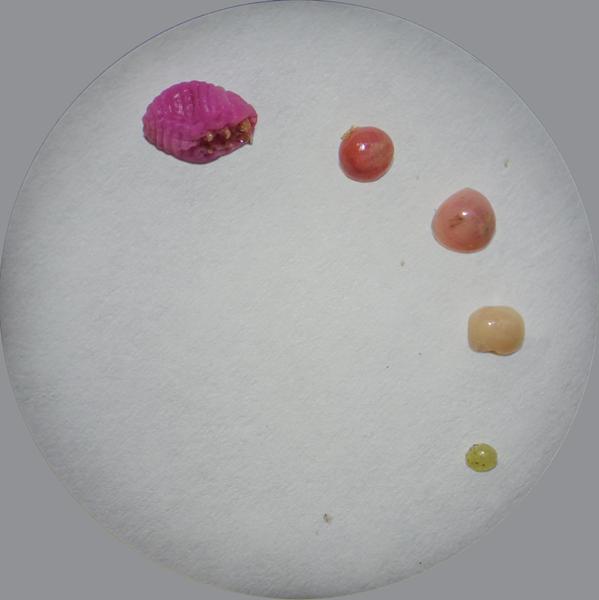Ground Pearls in Turf
en Español / em Português
El inglés es el idioma de control de esta página. En la medida en que haya algún conflicto entre la traducción al inglés y la traducción, el inglés prevalece.
Al hacer clic en el enlace de traducción se activa un servicio de traducción gratuito para convertir la página al español. Al igual que con cualquier traducción por Internet, la conversión no es sensible al contexto y puede que no traduzca el texto en su significado original. NC State Extension no garantiza la exactitud del texto traducido. Por favor, tenga en cuenta que algunas aplicaciones y/o servicios pueden no funcionar como se espera cuando se traducen.
Português
Inglês é o idioma de controle desta página. Na medida que haja algum conflito entre o texto original em Inglês e a tradução, o Inglês prevalece.
Ao clicar no link de tradução, um serviço gratuito de tradução será ativado para converter a página para o Português. Como em qualquer tradução pela internet, a conversão não é sensivel ao contexto e pode não ocorrer a tradução para o significado orginal. O serviço de Extensão da Carolina do Norte (NC State Extension) não garante a exatidão do texto traduzido. Por favor, observe que algumas funções ou serviços podem não funcionar como esperado após a tradução.
English
English is the controlling language of this page. To the extent there is any conflict between the English text and the translation, English controls.
Clicking on the translation link activates a free translation service to convert the page to Spanish. As with any Internet translation, the conversion is not context-sensitive and may not translate the text to its original meaning. NC State Extension does not guarantee the accuracy of the translated text. Please note that some applications and/or services may not function as expected when translated.
Collapse ▲Description
Ground pearls are scale insects belong to the family Margarodidae. Ground pearls appear as small, pearl-like formations on the roots or in the thatch, just below the soil surface. The adult female ground pearl is a wingless, pinkish scale insect, about 1⁄16 inch long with well-developed forelegs and claws (Figure 1). The male is a gnat-like insect smaller than the female, but with a slender waxy "tail" up to 1⁄4 inch long. Adults are typically active in late spring and early summer. Clusters of pinkish-white eggs are laid in a white waxy sac. The actual "pearl" shape is represented by the nymph which is covered with a hard, globular, yellowish-purple shell. Encysted nymphs are up to 1⁄16 inch in diameter (Figure 1).
Biology
Ground pearls are potentially serious problems in both southeastern and southwestern states. The roots of Bermuda-, St. Augustine-, zoysia-, and centipedegrasses are most commonly infested with ground pearls. Ground pearl nymphs extract juices from underground plant parts. Attack to the roots may cause circular dead areas that resemble fairy ring. The damage is most apparent during dry spells as irregular patches of grass turn yellow. The grass in these spots eventually turns brown and usually dies by fall. The spots enlarge each year and only weeds grow in the infested areas. Overwintering takes place in the pearl stage. Females usually mature in late spring and emerge from their cysts. After a brief period of mobility, females tunnel 2 to 3 inches into soil and secrete a waxy coat. Within this protective covering, females develop eggs (without mating) and deposit them throughout early summer. Approximately 100 eggs are laid by each female. The slender nymphs emerge in mid-summer and infest grass rootlets. Once they initiate feeding, nymphs soon develop the familiar globular appearance. There is usually one generation each year. However, if conditions are not favorable for emergence, female nymphs may remain in the pearl stage for several years.
Control
Cultural Control
When establishing new turf with sod or sprigs, check the roots to avoid planting infested grass. Watering, liming and fertilizing as prescribed by a soil test, proper mowing height with a sharp blade and other good cultural practices may help lawns recover from ground pearl injury, but such recovery may be temporary. Other warm season types of turf, such as bermudagrass, carpetgrass (Axonopus spp.) or bahiagrass, appear to be less sensitive to ground pearls and should be considered for lawns with severe ground pearl problems. Be sure to thoroughly clean equipment as it moves between sites to minimize the spread of ground pearls.
Chemical Control
Although some products containing the combination of bifenthrin + zeta-cypermethrin are labelled for ground pearl control, these active ingredients are not effective against a ground pearl infestation. Research at Clemson University evaluated insecticide applications for ground pearl control and found that three months post-treatment, no product had an impact on ground pearl populations. At nine months, products containing the active ingredients clothianidin (combined with a wetting agent) and thiamethoxam seemed to have some efficacy but do not provide "great" control. One thing to note is that broad-spectrum insecticides (particularly products like Sevin that have the active ingredient carbaryl) had higher numbers of cysts and likely have a negative impact on beneficial natural enemies (Chong, 2018). Ultimatley, maintaining a healthy, vigorous lawn in hopes of minimizing damage is the best current recommendation.
References
- Ground Pearls in Turf. Chong, J.-H. 2018. Golf Course Management. doi: https://www.gcmonline.com/course/environment/news/ground-pearls-turf
- Common name: ground pearls, scientific name: Margarodes spp. (Insecta: Hemiptera: Margarodidae). Camerino, A. 2015 (revised). Featured Creatures. Entomology & Nematology, FDACS/DPI, EDIS. Publication EENY-277
- Don't Give up on Ground Pearls. Brandenburg, R. 2009. Grounds Maintenance.
- Ground pearls: a generic revision of the Margarodidae sensu stricto (Hemiptera: Sternorrhyncha: Coccoidea). Foldi I. 2005. Annales de la Société Entomologique de France (n.s.), 41: 81-125.
- Pest Control for Professional Turfgrass Managers. Bowman, D. et al. 2017. NC State Extension Publication AG-408. 81 pp.
- Extension Plant Pathology Publications
- Horticultural Science Publications
- North Carolina Agricultural Chemicals Manual
For assistance with a specific problem, contact your local Cooperative Extension center.



